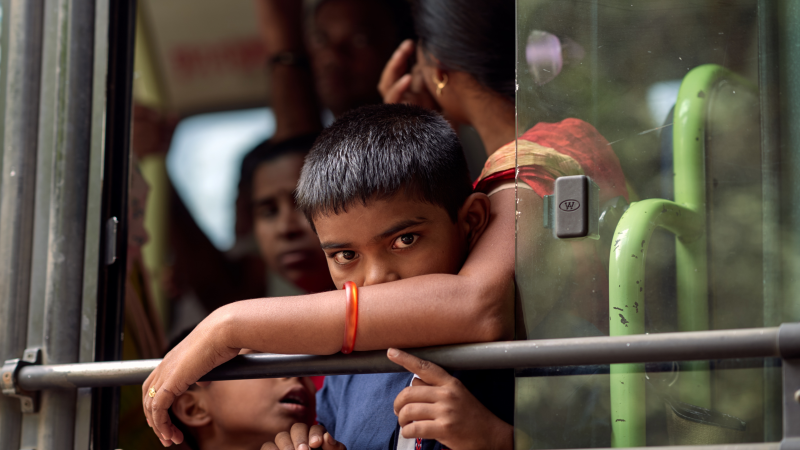
Image: Vladimir Buynevich from Pixabay
An efficient administration ensures primary public services like roads, transport, schools, and other social components are accessible to all. Social equity is a term used to define fair and equitable access to these components. Access to schools is a prerequisite for a progressive society and an important parameter governing social equity. An adequate transport system in a region plays a vital role in enabling more children to attend school. An efficient transport system, therefore, enhances the educational equity factor.
Dr Gopal Patil and Mr Gajanand Sharma from the Department of Civil engineering at the Indian Institute of Technology Bombay (IIT Bombay) conducted a rigorous analysis to measure how private and existing public transport systems were accessible for children to go to school. Their study focused on the Greater Mumbai region, and their research was published in Cities, an Elsevier journal.
The researchers assessed whether a region had adequate public transport, uniform distribution and a sufficient number of schools in the area, and how these factors can help achieve equitable distribution of school facilities for the children. They coll2²ected information with several variable parameters such as time taken to travel to schools, the number of students enrolled in the schools, ease of getting public and private transport, and many more.
Results of their study indicate that the transport facilities are not equally distributed in all regions of Greater Mumbai. Some parts have ample bus stops and established railway lines, thereby providing adequate access to schools. For schools located far off and having good railway connectivity, that is, across zones and travel times of 40-60 minutes or more, public and private transport are equally accessible. The study posits that educational inequities across the city need to be bridged. The study’s authors suggest a few measures to overcome them, which could come in handy for framing policy and infrastructural planning in the city.
The researchers analysed 4308 schools situated in the 577 zones defined by the Municipal Corporation of the Greater Mumbai region, which extends to nearly 460 sq. km. The researchers used Geographic Information System (GIS) software to locate the schools, nearest bus stops, and other relevant geographical parameters. They then assessed how each school was connected to transport facilities. Finally, they categorised the access to schools based on the time taken to travel to them: 10 to up to 40 minutes.
The researchers then mapped the availability of transport facilities to the schools within a zone and between the other 576 zones. They also factored in gender-specific parameters (based on the numbers enrolled in schools), private and public transport travel times, road and rail transport facility, enrollment level in schools, and other related factors. They then employed spatial data analysis algorithms and software techniques to analyse the voluminous dataset.
Lorenz curve is a graphical method used to analyse the inequalities – in this case, the accessibility of schools versus the student population – for various situations. A parameter called the Gini index – the ratio of the area between the line of equity and the Lorenz curve to the area between the line of equity and horizontal axis – gives a measure of the existing inequality.
Ideally, the Lorenz curve will be a straight line if a facility is uniformly available throughout the population. Deviation from this straight line depicts the inequity of accessing a facility. A Gini index of zero coincides with the ideal situation; as the number increases, it indicates the facility’s non-uniform level of accessibility. A Gini index of 1 is considered as a highly unfair distribution.
“We found that Greater Mumbai indicated a Gini index of 0.5 to 0.7 across various zones for several parameters,” says Dr Patil.
For the transport facility component, their analysis indicates that access to public transport is relatively poor for 10-40 minutes of travel time to school in many areas. Accessibility by private transport was more easily available than public transport for these travel times. However, for the time range of 40-60 min or even 90 minutes, there appears to be little gap in accessibility between public and private transport means along the railway line. “We found that most of the adequate facilities were along the rail routes. Areas surrounding them offered equitable access to transportation and normalised the travel time,” adds Dr Patil.
The researchers also found that high schools were lesser in number than primary schools and also situated far off. Moreover, the accessibility of secondary schools was lower than that of the primary schools, adding to the inequity. A high school education helps an individual’s overall development, and poorer access to them also impacts their employability.
The researchers found that the peripheral regions such as Bhandup and Gorai lack sufficient schools, whereas the public transport in areas such as Mankhurd, Mahul, and Trombay need ramping up.

Image courtesy: Authors of the study
“Our research evaluated spatial and social equity from an urban planning and transportation perspective, and provides a framework for policy measures to address the existing inequalities,'' say the authors of the study.
Their study suggests that Greater Mumbai needs to increase the number of schools, buses, and local train routes in several areas.
Dr Patil adds, “We will revise our analysis and update the results once the current phase of the metro line becomes functional.”
This article has been run past the researchers, whose work is covered, to ensure accuracy.






